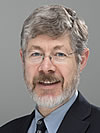 Daniel H. Sandweiss |
2016 Rip Rapp Archaeological Geology Award
Presented to Daniel H. Sandweiss
Citation by Fred Andrus
The 2016 recipient of the Rip Rapp Award in archaeological geology is Daniel H. Sandweiss. Dan deftly applies a diverse array of geoscience methods to answer questions central to Andean archaeology and important to anthropology worldwide, such as human responses to climate change, the peopling of the Americas, subsistence and domestication, trade and migration pathways, and the overall trajectory of Andean civilization.
Dan earned his Ph.D. in anthropology from Cornell University, where his dissertation focused on the time immediately before the Spanish conquest of the Andes, but his subsequent research over his career at the University of Maine spans the terminal Pleistocene to the historic. While his education was primarily in anthropology, earth-science methods are central to nearly all of his analyses, and he works with experts in diverse fields. However, he does not merely hire specialists to analyze aspects of his excavations and artifacts, but rather immerses himself in the details of the arguments and methods of these specialties. To collaborate with Dan is a true intellectual partnership. It is his simultaneous understanding of scientific analytical tools and critical anthropological questions that permits him to apply novel approaches so successfully. An abbreviated list of methods he has employed would include paleobiogeography, sclerochronology, isotope geochemistry, paleoethnobotany, zooarcheology, geomorphology, geophysics, and lithic geochemical provenance, in addition to meticulous application of classical excavation techniques. This work has made him a central figure in developing archaeologically relevant paleoclimate proxies, reconstructing the history of El Niño, identifying the earliest occupations of coastal South America, discovering the domestication of key Andean crops, mapping highland-lowland connectivity in trade and migration, and defining the economic foundations of Andean civilization and cities. He publishes prolifically, with more than 75 papers in the top scientific and anthropological journals, and has written or edited over 20 books and volumes, even while serving as a teacher, mentor, and leader in his university and several professional organizations.
Dan Sandweiss’ research exemplifies the interdisciplinary innovation the Rip Rapp Award seeks to recognize and promote.
 2016 George (Rip) Rapp Archaeological Geology Award — Response by Daniel H. Sandweiss
2016 George (Rip) Rapp Archaeological Geology Award — Response by Daniel H. Sandweiss
I was surprised, humbled, and extremely grateful to Fred Andrus and the GSA Archaeological Geology Division for this award. However, the recognition belongs equally to my mentors and colleagues, many named below. Being associated (even just in name) with George “Rip” Rapp only deepens the honor.
As an undergraduate at Yale in the late 1970s, I became interested in the potential that mollusk valves held for understanding past human behavior and the environments in which coastal people lived. Though I had not yet heard of geoarchaeology and took no geology courses, archaeologists Harry Merrick and Harvey Weiss opened my eyes to the potential of an interdisciplinary approach to the past. I built my NSF grad fellowship application around merging archaeology and geology even though I had never actually tried to do it.
At Cornell, my graduate advisor Tom Lynch (a geoarchaeologist by inclination) suggested I talk with Art Bloom. Art quickly pointed out how much catching up I had to do in order to apply earth science approaches to archaeology—and then guided me for years in doing so. As a beginning grad student spending a year in Peru, I also had the great fortune to work with Mike Moseley, a pioneer of the geoarchaeological approach in the Andes. One day in 1980, he introduced me to Jim Richardson, Harold “Bud” Rollins, and Jack Donahue (a former recipient of this award) and sent us off to see the Niño-built beach ridges and anomalous mollusks I had found on the coast near Santa, Peru. It was there, over beer at a zinc-topped bar in an old hotel that we first developed the “birth of EI Niño” hypothesis. One way or another, human eco-dynamics around El Niño in coastal Peru have dominated my work ever since.
After a three-year hiatus digging a large pyramid center in Peru with Thor Heyerdahl, I returned to the States for a post-doc at the Carnegie Museum with Richardson. In 1992, I was fortunate enough to land a job in the Institute for Quaternary Studies (now Climate Change Institute) and Anthropology Department at the University of Maine. The Institute was built on interdisciplinary principles and has proven a great home base. Research anywhere within the broad area of Quaternary studies is equally valued. Much of my work over the last quarter century has been with earth science colleagues in the Institute—Kirk Maasch, Hal Borns, Dan Belknap, and Alice and Joe Kelley in particular.
The eco-dynamics of EI Niño are becoming ever more interesting. For instance, Holocene behavior of the phenomenon is proving even more complex than we suggested several decades ago; El Niño-driven landscape construction seems implicated in first millennium AD settlement planning for monumental centers on the north coast of Peru; we have recently shown how demography intersected with climate in shaping the far north coast; and new records of El Niño are being developed, some in direct association with archaeological sites. Exciting times at the intersection of earth science, life science, and archaeology!
